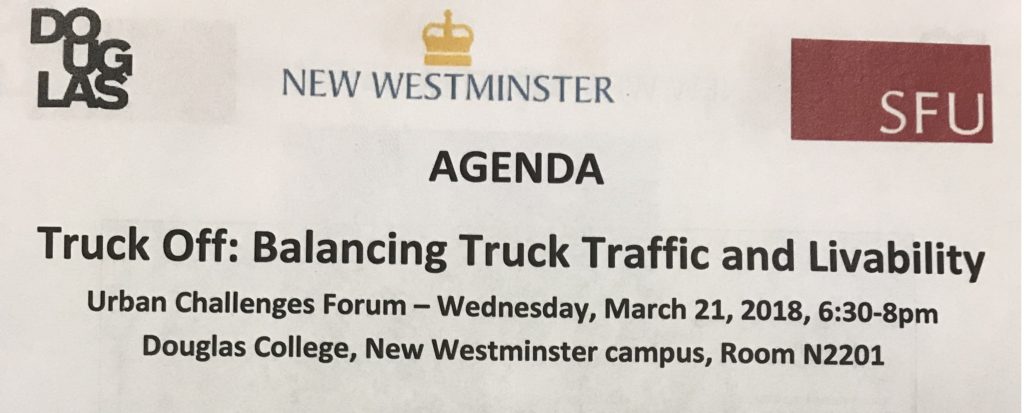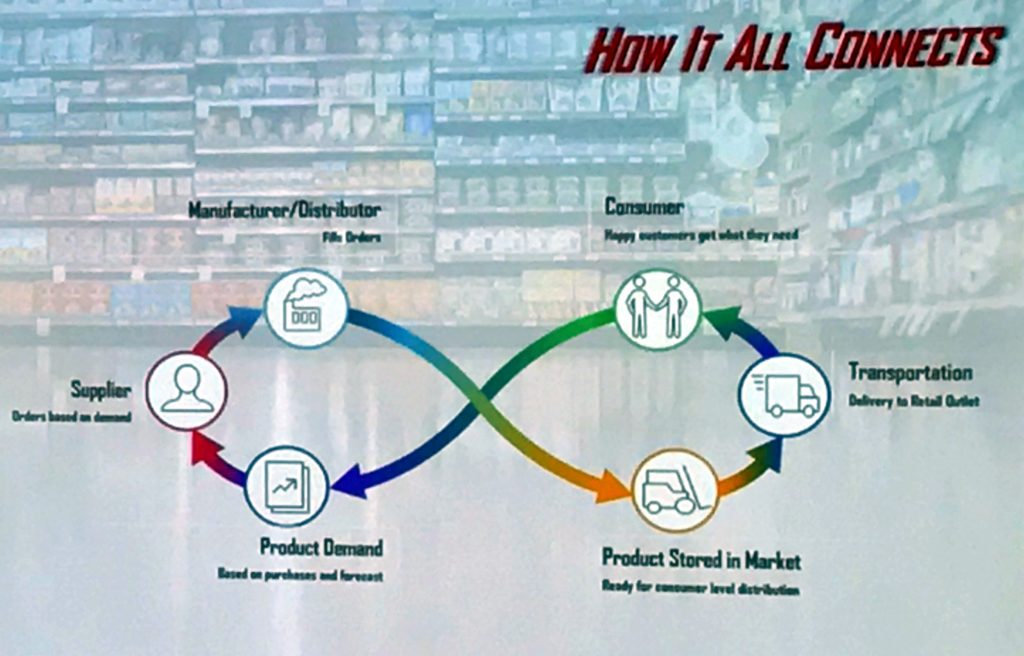Douglas College has been running an interesting talk series this year under the banner of “Urban Challenges Forum”. The final episode of this semester occurred on Wednesday night, and deserved a better turnout than it received, considering the amount of social media bits and watercooler shatter we have in New Westminster around the topic: the livability impacts of truck routes and goods movement in our community.

Fortunately, they recorded video of the event, and will (hopefully?) be posting it on line. It is worth the time to see how the four panelists speak about trucks from different viewpoints: an urban systems geographer, a representative of the trucking industry, a representative of the Port Authority, and the CAO of New Westminster, a City that is (arguably) impacted most by the negative externalities of “goods movement” in the region.
I want to give a quick summary of my take-away points before raising the question I never got to raise at the event, partly because of the time constraints, partly because no-on needs to hear from a Politician when actual thinking people are speaking, and partially because I wasn’t sure how to phrase my question in the form of a question*.
Peter Hall (the geographer) reminded us that transportation, by its very nature, makes us selfish, and makes us act in shamefully selfish ways (speeding, tailgating, yelling at others). This is at least partly because it isn’t an ends, but a means, and its hassles are preventing us from meeting these ends. Add to this our general ignorance about freight, and we get a selfish ignorance about goods movement – we all want the benefits, none of us understand why we need to tolerate the costs. Trucking also has many benefits and externalities, and they are not evenly distributed. Altogether, this makes it a vicious political problem, not made easier by jurisdictional overlap.

Matthew May from BST Transport and Peter Xotta from the Port of Vancouver gave similar messages about their respective industries: they need to keep the goods moving in the National Interest. You ask for tomatoes in the store, you need to deal with trucks. You want a vibrant economy, you need trucks and ports. You live in a Gateway, and we will accommodate your community as best we can (even want to make you happy!), but the mandate is to drive the economy.
Lisa Spitale gave a concise summary of some of the interface issues New Westminster has dealt with over the last few decades. With rail and roads encircling the community and a Regional Growth Strategy mandate to be a dense Urban Centre supported by (and supporting) transit, we are a hot spot for the externalities of goods movement, by rail and truck.
If I had a point to make at this event (again, I could not put this in the form of a question), it is that we have *chosen* to accept the level of negative externalities that come with a large number of diesel trucks in our neighbourhoods.
To frame this point, we need to put aside the local-goods-delivery for a moment and talk about the larger getting-stuff-from-Port-to-hinterland-through-logistics-hubs part of this equation. This is what separates us as a “Gateway” city from most other regions, and is the foundation of both the Port’s arguments on this issue and the emphasis of the Gateway Council model that has commonly dominated our regional transportation conversation. But what kind of Gateway have we built?
Here in New Westminster, we host one end of a 114-year-old single-track swing bridge that is the only rail link crossing the Fraser River west of Mission. The City of New Westminster has something like 14km of river shoreline under Port of Vancouver jurisdiction, with about a third of that backed by industrial land, much of it under the Port’s direct control. Much of this land is used for logistics, cross-shipping, container storage, and other aspects of that all-important gateway-to-the-hinterland business. Yet over all of that space there are (2) conveyors moving aggregates and chips on/off barges, and one (1) pier occasionally used to move breakbulk lumber. These are the only location in New Westminster’s extensive port lands where anything is taken on or off of a boat.
The only contribution our Port lands make to the Gateway is providing space to move and store trucks, and facilitate the movement of goods in and out of trucks. Unfortunately, New Westminster is not alone in this.
How we move goods through the region is a choice we make, not a foregone conclusion. For these hinterland goods in containers, we have chosen to use trucks to move a large portion of them intra-regionally. A cynic would suggest that is because building waterfront infrastructure to make better use of short sea shipping and barges is expensive. Upgrading rail infrastructure so a single swing bridge isn’t the only vital link across a river that has seen 30 lanes of highway built across since that single track was installed, is expensive. Relying on roads and bridges is comparatively cheap from the view of the person who has to pay for the initial capital, because taxpayers will often pony up for “congestion reduction” investment, and the other costs (noise, pollution, public safety) are completely externalized, at least partially in the form of decreased livability of our communities.
Since 1808 when Simon Fraser first tasted salt in the Sto:lo, there have been strains resulting from the needs of the Gateway to the Hinterland and the needs of the people living on the river’s shores. We can, however, find a better balance between these forces. It must include acknowledging that externalized costs of fueling the Gateway need to be accounted. Trucks are part of a functioning modern society, but their true role cannot be understood as long as we subsidize them over other options.
*I was once at a forum-type event where the request for “question from the floor” was prefaced by this proviso: Your first sentence must be in the form of a question; there should not be a second sentence. I thought that was brilliant.